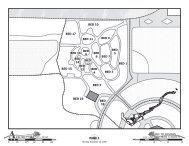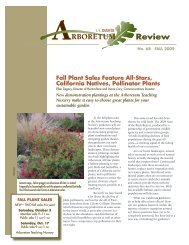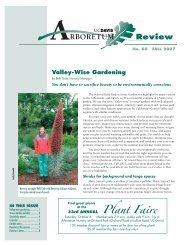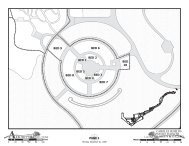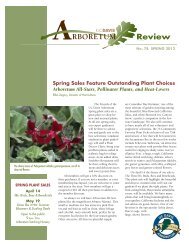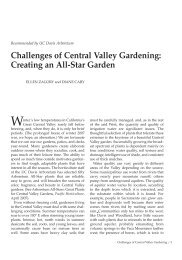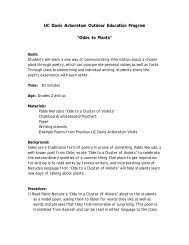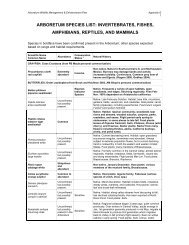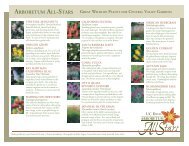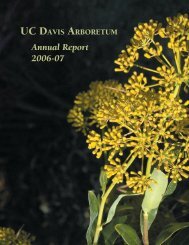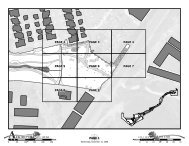SHOULD I GROW A - the UC Davis Arboretum
SHOULD I GROW A - the UC Davis Arboretum
SHOULD I GROW A - the UC Davis Arboretum
Create successful ePaper yourself
Turn your PDF publications into a flip-book with our unique Google optimized e-Paper software.
<strong>SHOULD</strong> HOULD I <strong>GROW</strong> ROW A<br />
You decide. But since coast redwoods do not naturally grow here<br />
in <strong>the</strong> Central Valley, it’s important to learn more.<br />
• Long-living, attractive trees<br />
with few diseases<br />
• Provide shade for cool<br />
summer refuge<br />
• Fast-growing trees provide<br />
privacy and wind screen<br />
(grow up to five feet per year)<br />
• Once redwoods are established<br />
(after five years), need less<br />
watering<br />
• Fallen leaves on ground<br />
dampen noise<br />
• Plant near a lawn for easy<br />
watering, but over time,<br />
redwood will shade out lawn<br />
• Redwoods are very large (up to 50 feet<br />
tall, 15 feet diameter canopy) and need<br />
sufficient room to grow<br />
• May need to have <strong>the</strong> top cut off to clear<br />
power lines<br />
• Redwoods are high water users and will<br />
always need extra summer water; young<br />
trees need water year round<br />
• Redwoods keep leaves all year and block<br />
sun in winter<br />
• Boron in local water turns needles brown<br />
• Redwoods planted here never look as<br />
healthy as <strong>the</strong>y do on <strong>the</strong> coast<br />
• Redwoods need well-drained soil<br />
so roots can get oxygen<br />
Robert Potts © California Academy of Sciences<br />
Can you imagine<br />
this in your yard?
HOW OW M<strong>UC</strong>H <strong>UC</strong>H DO O YOU OU KNOW NOW ABOUT BOUT<br />
How tall do<br />
coast redwood<br />
trees grow?<br />
Do coast redwood<br />
trees grow naturally<br />
all over <strong>the</strong> world?<br />
Why are coast redwoods<br />
so popular as a<br />
source of lumber?<br />
Test Yourself and See!<br />
Do coast redwood trees<br />
grow naturally on <strong>the</strong><br />
<strong>UC</strong> <strong>Davis</strong> campus?<br />
Sherry Ballard © California Academy of Sciences<br />
How long can<br />
coast redwood<br />
trees live?<br />
How fast do<br />
coast redwood<br />
trees grow?<br />
Is <strong>the</strong> coast redwood<br />
<strong>the</strong> same tree as <strong>the</strong><br />
giant sequoia?<br />
Robert Potts © California Academy of Sciences
Courtesy of Save <strong>the</strong> Redwoods League<br />
Coast<br />
Redwood<br />
HOW OW M<strong>UC</strong>H <strong>UC</strong>H DO O YOU OU KNOW NOW ABOUT BOUT<br />
Coast redwoods can grow<br />
over 350 feet tall.<br />
Statue of<br />
Liberty<br />
368’ They are <strong>the</strong><br />
320’ tallest trees in <strong>the</strong><br />
287’ world! The tallest<br />
trees are taller than<br />
<strong>the</strong> Statue of Liberty<br />
and <strong>the</strong> nation’s<br />
capitol building.<br />
National<br />
Capitol Dome<br />
No. The only place in <strong>the</strong><br />
world that coast redwood<br />
trees grow naturally is along<br />
<strong>the</strong> coast of California and<br />
sou<strong>the</strong>rn Oregon.<br />
However, redwoods have been PLANTED<br />
all over <strong>the</strong> world, in many types of climates<br />
that are very different from coastal Oregon<br />
and California.<br />
Crescent City<br />
Eureka<br />
Garberville<br />
OREGON<br />
Guerneville <strong>UC</strong> DAVIS<br />
Sacramento<br />
Los Angeles<br />
250 Miles<br />
San Francisco<br />
Santa Cruz<br />
Monterey<br />
Redwood tree lumber<br />
is resistant to decay.<br />
Tannins and o<strong>the</strong>r natural chemicals in coast redwood<br />
make it resistant to many common plant enemies, like insects,<br />
fungi and o<strong>the</strong>r disease-causing organisms.<br />
This property also slows down <strong>the</strong> natural decay process of<br />
wood and makes coast redwood lumber last longer than material<br />
from o<strong>the</strong>r tree species.<br />
Most redwood lumber today comes from managed secondgrowth<br />
forests and not <strong>the</strong> few remaining old-growth forests<br />
in California.<br />
NEVADA<br />
CALIFORNIA<br />
Courtesy of Save <strong>the</strong> Redwoods League<br />
Test Yourself and See!<br />
No. Although coast redwoods are not<br />
native to <strong>the</strong> campus or <strong>the</strong> <strong>Davis</strong> area,<br />
<strong>the</strong>y have been planted here.<br />
Redwoods planted in <strong>the</strong> Central Valley are irrigated to<br />
ensure survival. They are one of <strong>the</strong> most common landscape<br />
plants on <strong>the</strong> <strong>UC</strong> <strong>Davis</strong> campus and in <strong>the</strong> <strong>Arboretum</strong>. Coast<br />
redwoods in <strong>the</strong> Central Valley can reach heights of 50 feet.<br />
You can see natural redwood forests within a two hour drive<br />
of here near <strong>the</strong> coast.<br />
Sherry Ballard © California Academy of Sciences<br />
Coast redwoods can live longer<br />
than 2,000 years.<br />
A mature redwood forest is composed of trees 500-1,000<br />
years old on average. The trees in this redwood grove are<br />
approximately 65 years old.<br />
Coast redwoods can grow<br />
three to ten feet per year.<br />
Redwoods are among <strong>the</strong> fastest-growing trees on earth.<br />
A redwood achieves most of its vertical growth within <strong>the</strong> first<br />
100 years of its life. One of <strong>the</strong> reasons coast redwoods are a<br />
highly desired timber species is because <strong>the</strong>y grow so quickly<br />
in forests managed for harvest.<br />
No, but <strong>the</strong>y are in <strong>the</strong> same plant<br />
family (Taxodiaceae).<br />
The coast redwood (Sequoia<br />
sempervirens) is native to <strong>the</strong> coast of<br />
California and sou<strong>the</strong>rn Oregon and is<br />
<strong>the</strong> tallest tree on earth. The giant<br />
sequoia (Sequoiadendron gigantea) is<br />
native to <strong>the</strong> Sierra Nevada mountains of<br />
California and is <strong>the</strong> largest living thing<br />
on earth. Both trees are considered<br />
California’s State Tree.<br />
Crescent City<br />
Eureka<br />
Garberville<br />
OREGON<br />
Guerneville <strong>UC</strong> DAVIS<br />
Sacramento<br />
Los Angeles<br />
250 Miles<br />
San Francisco<br />
Santa Cruz<br />
Monterey<br />
NEVADA<br />
CALIFORNIA<br />
Giant Sequoia forests<br />
Courtesy of Save <strong>the</strong> Redwoods League<br />
Robert Potts © California Academy of Sciences
ARE RE THE HE COAST OAST REDWOOD EDWOOD’S<br />
LIFE IFE INSURANCE<br />
NSURANCE<br />
When a redwood tree is injured or<br />
killed, sprouts can ensure its survival.<br />
Sprouts are clones, meaning <strong>the</strong>y are genetically<br />
identical to <strong>the</strong> parent tree. A redwood tree’s<br />
genetic material will survive through its sprouts.<br />
Although redwood trees are disease- and<br />
pest-resistant, natural disturbances, like fires<br />
and floods, can damage redwood trees.<br />
Notice <strong>the</strong> redwood sprouts in front of you. Coast<br />
redwoods are among <strong>the</strong> few cone-bearing trees with<br />
<strong>the</strong> ability to sprout. This ability likely contributes to<br />
<strong>the</strong> dominance of <strong>the</strong> redwood tree in California’s<br />
nor<strong>the</strong>rn coastal forests.<br />
Ernesto Sandoval<br />
Sherry Ballard © California<br />
Academy of Sciences
WHERE HERE CAN<br />
AN<br />
Courtesy of Save <strong>the</strong> Redwoods League<br />
Old-growth coast redwood forests<br />
Second-growth and managed redwood forests<br />
Crescent City<br />
Eureka<br />
Garberville<br />
OREGON<br />
Guerneville<br />
Redwood National<br />
and State Parks<br />
112,000 total acres (39,000 acres<br />
of old-growth), 6.5 hour drive<br />
Humboldt Redwoods<br />
State Park<br />
52,000 total acres (17,000 acres<br />
of old-growth), 4.5 hour drive<br />
San Francisco<br />
Santa Cruz<br />
Los Angeles<br />
250 Miles<br />
I GO O TO O SEE EE<br />
AN I G<br />
<strong>UC</strong> DAVIS<br />
Sacramento<br />
Monterey<br />
T. Elliot Weier<br />
Redwood Grove<br />
Planted 1941<br />
Armstrong Redwoods<br />
State Reserve<br />
875 total acres (75 acres of<br />
old-growth), 2 hour drive<br />
Muir Woods National<br />
Monument<br />
560 total acres (all old-growth),<br />
1.5 hour drive<br />
NEVADA<br />
Big Basin Redwoods State Park<br />
Established 1902 (first CA state park)<br />
18,000 total acres (4,700 acres of old-growth),<br />
2.5 hour drive.<br />
Henry Cowell Redwoods<br />
State Park<br />
2,000 total acres (3 acres of old-growth),<br />
2.5 hour drive<br />
CALIFORNIA<br />
Old-growth coast redwood forests are ancient forests that have experienced little disturbance<br />
by humans. Today fewer than 5% of <strong>the</strong> original old-growth forests remain untouched. Redwood<br />
trees still grow in most of <strong>the</strong> original old-growth range, but <strong>the</strong>y primarily grow in forests<br />
managed for lumber.<br />
REDWOOD EDWOOD FOREST OREST?<br />
What Are <strong>the</strong> Ecosystem Benefits of<br />
Old-Growth Coast Redwood Forests?<br />
• Tall trees shade forest floor and stream waters,<br />
keeping temperatures cool for wildlife<br />
• Coast redwood trees collect water from fog during<br />
summer months, which provides extra moisture to<br />
<strong>the</strong> forest during <strong>the</strong> dry season<br />
• Dead and decaying logs return nutrients to <strong>the</strong> soil<br />
• Plant roots help stabilize soil and keep soil from<br />
washing away during floods<br />
• Layers of vegetation<br />
provide habitat for over<br />
200 species of wildlife<br />
Black Bears (Ursus<br />
americanus) climb up to 100<br />
feet in <strong>the</strong> redwoods to find<br />
food. They eat <strong>the</strong> cambium<br />
layer of wood found right<br />
beneath coast redwood bark.<br />
Jeffrey Rich Nature Photography<br />
Chinook Salmon (Oncorhynchus<br />
tshawytscha) need cool water<br />
temperatures and reproduce in<br />
pools created by logs that fall<br />
in streams.<br />
Jeffrey Rich<br />
Nature Photography<br />
Jeffrey Rich<br />
Nature Photography<br />
Nor<strong>the</strong>rn Spotted Owls<br />
(Strix occidentalis<br />
caurin) prefer cooler<br />
temperatures provided<br />
by <strong>the</strong> dense tree cover<br />
in undisturbed redwood<br />
forests. They nest in<br />
abandoned tree cavities<br />
created by woodpeckers.<br />
© 2000 William Leonard<br />
Banana Slugs (Ariolimax columbianus)<br />
eat dead plant and animal matter,<br />
helping to recycle nutrients in <strong>the</strong><br />
coast redwood forest.<br />
Robert Potts © California Academy of Sciences
Drinking<br />
Shallow roots absorb water<br />
that drips off <strong>the</strong> trees from<br />
winter rain and summer fog.<br />
In regions without summer<br />
fog, redwoods need irrigation.<br />
Like those of o<strong>the</strong>r trees, redwood’s surface roots can be<br />
damaged by compaction from foot traffic and machinery.<br />
Redwood roots can extend over<br />
50 feet in every direction.<br />
Roots of neighboring redwoods often interlock.<br />
This network of roots provides added stability.<br />
HOW OW DO<br />
HELP ELP COAST OAST REDWOODS EDWOODS<br />
Breathing Stabilizing<br />
Shallow roots absorb necessary<br />
oxygen from <strong>the</strong> top layers of<br />
soil. The top layers of <strong>the</strong> soil<br />
are more oxygen-rich than <strong>the</strong><br />
deeper layers.<br />
Because <strong>the</strong>re is plentiful surface water available, redwoods<br />
don’t need deep roots to reach water reserves.<br />
Floods are common in some redwood ecosystems and can deposit sediments<br />
that bury and suffocate roots. Unlike o<strong>the</strong>r trees, buried redwood trunks can<br />
sprout new roots that quickly grow into <strong>the</strong> new soil to access oxygen where<br />
it is more plentiful.<br />
Extensive shallow roots<br />
form a dense mat that helps<br />
keep redwoods from falling<br />
in storms and floods.<br />
Most redwood roots are located<br />
in <strong>the</strong> top three feet of soil.<br />
Robert Potts © California Academy of Sciences
Ellen Zagory<br />
THIS HIS BENCH ENCH IS S MADE ADE FROM ROM<br />
The decay-resistant qualities of redwood wood make it an extra long-lasting<br />
building material. This bench is made from recycled redwood lumber from<br />
an old <strong>UC</strong> <strong>Davis</strong> bridge.<br />
Ernie Head helped build <strong>the</strong> original tables in <strong>the</strong><br />
T. Elliot Weier Redwood Grove in 1954. In 2004,<br />
Mr. Head (left) and Hal Sconyers, representing <strong>the</strong><br />
Rotary Club of <strong>Davis</strong>, worked with <strong>Arboretum</strong> staff<br />
and student employees to construct new benches<br />
and tables for <strong>the</strong> grove using recycled redwood.<br />
Robert Potts © California<br />
Academy of Sciences
HOW OW IS RREDWOOD<br />
EDWOOD BARK ARK<br />
Redwood bark provides life-saving protection<br />
against threats from <strong>the</strong> environment.<br />
Tough, fibrous bark repels<br />
destructive insects.<br />
Tiny air pockets in <strong>the</strong> spongy<br />
bark insulate <strong>the</strong> living, inner part<br />
of <strong>the</strong> tree against temperature<br />
extremes from fire.<br />
Bark burns poorly and withstands<br />
<strong>the</strong> heat of wildfires because it<br />
contains almost no resins or<br />
volatile oils.<br />
Spongy bark up to one foot thick<br />
absorbs shock from falling branches<br />
and trees in <strong>the</strong> forest.<br />
Touch <strong>the</strong> bark on <strong>the</strong> log in front of you<br />
and feel for yourself.<br />
Sherry Ballard © California Academy of Sciences
NOTICE OTICE THE HE<br />
Sword fern (Polystichum munitum) grows<br />
in <strong>the</strong> shade provided by coast redwood trees.<br />
The canopy of <strong>the</strong> mature redwood forest is<br />
so dense that little sunlight reaches <strong>the</strong> forest<br />
floor. Understory plants like <strong>the</strong> sword fern<br />
thrive in moist, low-light conditions. They<br />
grow up to 1.5 feet tall and 3 feet wide.<br />
Look for sword ferns when you visit natural<br />
redwood forests.<br />
IN N FRONT RONT OF F YOU OU<br />
Redwoods National Park, Humbolt County, CA<br />
Sword ferns colonize<br />
large areas of <strong>the</strong> forest<br />
floor and flourish<br />
where o<strong>the</strong>r plants<br />
cannot.<br />
Sherry Ballard © California<br />
Academy of Sciences
IF F THESE HESE<br />
The trees in <strong>the</strong> Redwood Grove have been cared for by<br />
<strong>UC</strong> <strong>Davis</strong> students, faculty and staff for over 60 years.<br />
They have grown with <strong>the</strong> campus and <strong>the</strong> <strong>Arboretum</strong>.<br />
Planting<br />
Dr. T. Elliot Weier recruits<br />
<strong>UC</strong> <strong>Davis</strong> students to plant<br />
redwoods along <strong>the</strong> weedy<br />
creek in <strong>the</strong> newly formed<br />
<strong>Arboretum</strong>. <strong>UC</strong> <strong>Davis</strong> has<br />
only 1,200 students.<br />
Young redwoods were planted by hand on <strong>the</strong><br />
banks of Putah Creek in 1941.<br />
Understory Plants<br />
Plants native to <strong>the</strong> coastal<br />
redwood forests are planted<br />
under <strong>the</strong> shady canopy of<br />
<strong>the</strong> tall trees. The <strong>Arboretum</strong><br />
grove is one of <strong>the</strong> largest<br />
stands of coast redwoods<br />
outside <strong>the</strong>ir native range.<br />
A Special Gift<br />
<strong>UC</strong> <strong>Davis</strong> Senior Class Gift<br />
is dedicated to improvement<br />
of <strong>the</strong> Redwood Grove, a<br />
popular glen for relaxing and<br />
studying on <strong>the</strong> now urban<br />
campus. <strong>UC</strong> <strong>Davis</strong> student<br />
enrollment exceeds 25,000.<br />
<strong>Arboretum</strong> Archives<br />
Early Struggles<br />
Far from <strong>the</strong>ir cool coastal homes, <strong>the</strong><br />
young redwoods are watered with buckets<br />
from Putah Creek to keep <strong>the</strong>m alive<br />
through <strong>the</strong> hot Central Valley summers.<br />
Essential Irrigation<br />
Installation of water lines allows<br />
<strong>the</strong> redwoods to be manually watered<br />
with sprinklers. The redwoods are now<br />
established in <strong>the</strong> Central Valley soils<br />
and begin to grow taller.<br />
Dedication<br />
The Redwood Grove is dedicated to<br />
Dr. T. Elliot Weier, lifelong champion<br />
of <strong>the</strong> <strong>Arboretum</strong>. <strong>UC</strong> <strong>Davis</strong> has grown<br />
to 12,000 students.<br />
Dr. T. Elliot Weier at <strong>the</strong> Redwood Grove<br />
dedication ceremony in 1969.<br />
Renovation<br />
New paths, understory<br />
plantings, and seating<br />
areas create healthier<br />
growing conditions for<br />
<strong>the</strong> trees. The Rotary<br />
Club of <strong>Davis</strong>, Friends<br />
of <strong>the</strong> <strong>Davis</strong> <strong>Arboretum</strong>,<br />
<strong>UC</strong>D students and o<strong>the</strong>r<br />
community members help<br />
<strong>Arboretum</strong> staff complete<br />
<strong>the</strong>se improvements.<br />
David Freund<br />
Community volunteers<br />
assist in <strong>the</strong> renovation<br />
of <strong>the</strong> Redwood Grove.<br />
Wayne Tilcock<br />
Daniel Nakahara<br />
The Future<br />
Like thousands of students and<br />
community members before<br />
you, you can help support <strong>the</strong><br />
maintenance and development<br />
of <strong>the</strong> <strong>Arboretum</strong>. Consider<br />
honoring a loved one, friend<br />
or colleague with an inscription<br />
on <strong>the</strong> seating wall in front<br />
of you. Contact <strong>the</strong> <strong>UC</strong> <strong>Davis</strong><br />
<strong>Arboretum</strong> to learn more about<br />
memorial, commemorative and<br />
o<strong>the</strong>r giving opportunities.
Jeff Gnass Photography<br />
COAST OAST REDWOODS EDWOODS HAVE AVE THEIR HEIR OWN WN<br />
During dry summer months, hanging branches<br />
comb <strong>the</strong> passing coastal fog.<br />
Each waxy leaf ga<strong>the</strong>rs <strong>the</strong> tiny fog droplets into one<br />
big drop that is heavy enough to fall to <strong>the</strong> ground.<br />
The shallow roots absorb <strong>the</strong> water from this natural<br />
“drip” irrigation system that provides needed summer<br />
moisture.<br />
Redwoods on <strong>the</strong> coast comb water from summer fog.<br />
Although <strong>the</strong>re is little to no summer rain in <strong>the</strong>ir coastal climate, each redwood can comb up to<br />
four inches of water per day from fog! They get 25-50% of <strong>the</strong>ir yearly water needs from fog and<br />
<strong>the</strong> remainder comes from winter rain.<br />
Ellen Zagory<br />
Here at <strong>UC</strong> <strong>Davis</strong>, we use<br />
sprinklers to water <strong>the</strong> trees<br />
during our hot, dry summers.<br />
Sherry Ballard © California Academy of Sciences
DISCOVER ISCOVER MY<br />
The root mass in front of you is just<br />
a tiny portion of <strong>the</strong> coast redwood<br />
tree’s root system.<br />
The orange area represents <strong>the</strong> relative size<br />
of <strong>the</strong> root mass. Redwood roots from<br />
large trees extend laterally from <strong>the</strong> tree<br />
over 50 feet in every direction!<br />
Sherry Ballard © California<br />
Academy of Sciences
WHY HY IS S THIS HIS<br />
PLANTED LANTED IN N THE HE REDWOOD EDWOOD GROVE ROVE?<br />
It was planted here because it is a long-lost relative of<br />
<strong>the</strong> coast redwood from a remote region of central China.<br />
Close up of dawn redwood needles<br />
The dawn redwood (Metasequoia<br />
glyptostroboides) was thought to<br />
have gone extinct five million<br />
years ago but was rediscovered<br />
by a Chinese forester in 1941. The<br />
tree in front of you was planted in<br />
1990 from seed collected at natural Faber<br />
groves of dawn redwood in China. Betsy<br />
The dawn redwood can be a great<br />
landscape tree.* It is fast-growing,<br />
frost-tolerant and pest-free. Unlike<br />
<strong>the</strong> evergreen coast redwood, <strong>the</strong><br />
dawn redwood loses its leaves in<br />
<strong>the</strong> winter. This allows winter<br />
sunlight into <strong>the</strong> garden.<br />
* Not recommended for growing in areas with high salt<br />
or boron content in <strong>the</strong> water.<br />
Dawn redwood<br />
Betsy Faber
IS S THIS HIS PLANT LANT A<br />
No, but it sure is lucky.<br />
Here’s why: Redwood sorrel (Oxalis oregana) has a special ability<br />
to thrive in <strong>the</strong> low-light conditions of <strong>the</strong> shady redwood forest.<br />
Redwood sorrel OPENS its leaves<br />
to catch diffuse sunlight in <strong>the</strong> shady<br />
redwood forest. Where light levels are<br />
low, <strong>the</strong> sorrel thrives.<br />
Betsy Faber<br />
Redwood sorrel CLOSES, or folds,<br />
its leaves in intense, direct sunlight.<br />
Sorrel cannot survive long periods<br />
in direct light and folds its leaves like<br />
little umbrellas to avoid it.<br />
Betsy Faber<br />
Test Your<br />
Observation Skills:<br />
Are <strong>the</strong> redwood sorrel<br />
leaves in front of you<br />
in sun or shade?<br />
Robert Potts © California<br />
Academy of Sciences



